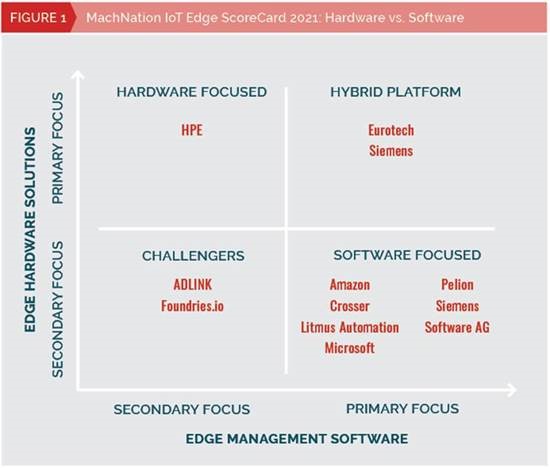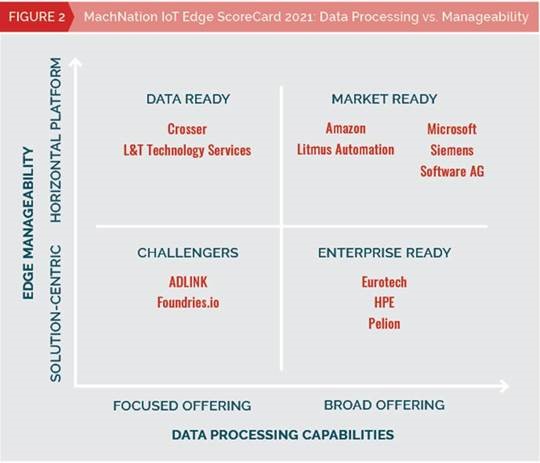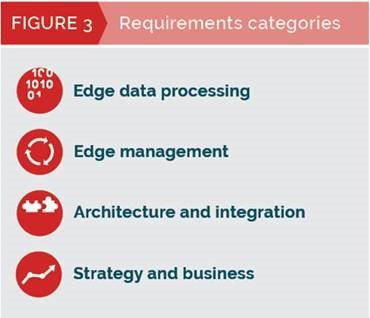We evaluated 12 IoT edge vendors, here’s four things to help you choose the right solution
Edge is a key enabler and a critically important component in Internet of Things (IoT) deployments today, says Josh Taubenheim, IoT analyst for the US-based IoT test lab, MachNation. Here he describes the four requirements for enterprises to consider when choosing an IoT edge vendor.
Edge platforms continue to play a vital role in the IoT ecosystem. Businesses deploying IoT solutions recognise that many optimally designed IoT solutions, especially those in the industrial vertical, take advantage of one or multiple edge components. In fact, MachNation research suggests that most IoT solutions in verticals such as manufacturing, commercial transportation, building automation, and logistics will leverage edge computing to meet business and operational requirements.
MachNation has published its fourth annual IoT Edge ScoreCard to aid enterprise, system integrator (SI), and service provider (SP) buyers in their research processes and to provide guidelines for the most important edge characteristics. We have conducted these analyses due to the great diversity in the quality of edge platforms and the technological heritage of the various platform vendors.
What is an IoT edge solution?
Not all uses of the term “edge” are thought of in the same way, and the definition of edge continues to evolve with the technology. According to MachNation definitions, edge platforms are distributed technology and processing architectures that bring certain computational and analytics capabilities near the point of data generation. Edge platforms enable certain processes to be decentralised and to occur in a more optimal physical location. This creates secure, reliable, and scalable IoT deployments, while also offering new opportunities for high-performance IoT solutions to generate business value.
Edge platform vendors generally provide the following data-centric microservices: data ingestion, data normalisation, data storage, rules engine, analytics, and visualisation. Edge vendors also provide the following management capabilities: remote configuration, remote software management, connectivity management, deployment flexibility, and edge autonomy. Edge technology components are part of an overall IoT solution architecture.
MachNation’s 2021 IoT Edge ScoreCard includes the following vendors (listed alphabetically): ADLINK, Amazon, Crosser, Eurotech, Foundries. io, HPE, Litmus Automation, L&T Technology Services, Microsoft, Pelion, Siemens, and Software AG.
MachNation selected a group of participating vendors that adequately represent the diversity of approaches and sizes in this burgeoning IoT edge market. No vendor was charged a fee to participate in MachNation’s IoT Edge ScoreCard.
MachNation’s 2021 IoT Edge ScoreCard rates vendors against the requirements of best-in-class software, hardware, and hybrid approaches to edge. MachNation recognises that today’s edge vendor landscape is both nascent and vibrant – offering myriad viable value propositions. As such, MachNation felt it important to include vendors that offer software-focused, hardware-focused, and hybrid offerings in this ScoreCard. (See Figure 1)

MachNation also believes it helpful to classify vendors by their edge data processing and edge manageability capabilities. This 2×2 matrix helps decision-makers understand vendors’ capabilities in edge data processing (e.g., data ingestion, data normalisation, data storage, rules engine, analytics, and visualisation) and edge manageability (e.g., remote configuration, remote software management, connectivity management, deployment, and autonomy). Using a traditional 2×2 matrix, MachNation classifies the types of IoT edge vendors into four buckets: market ready, data ready, enterprise ready, and challengers. (See Figure 2)

MachNation suggests that enterprises evaluate IoT edge vendors across four categories: level of sophistication for edge data processing capabilities, excellent edge management functionality, the overall platform architecture and availability of productised integrations, and the vendor’s strategy as well as their position in the IoT edge ecosystem of services. (See Figure 3)

Below, MachNation discusses those four requirement categories in more detail.
Edge Data Processing
Edge hardware and software is responsible for ingesting and processing machine and operational data from an IoT asset. This data can be delivered using a variety of connectivity options and protocols, the combination of which varies by industry and use case. Edge vendors must offer broad and extensive support for these southbound protocols and connectivity options in order to provide enterprises the ability to ingest and process data for their IoT edge solutions. Furthermore, IoT edge platforms should be able to store, process, perform analytics on, and visualise the data.
A sophisticated edge data processing model is critical for enterprises to generate business value from their edge deployments. MachNation evaluates the robustness of IoT edge platform’s data processing capabilities on 5 key sub-requirements: data ingestion model, data normalisation techniques, data storage flexibility, rules engine sophistication and analytics and visualisation capabilities.
Edge Management
Leading IoT edge platform vendors should build their platforms with sophisticated edge management capabilities. Edge management sophistication is demonstrated when vendors focus on providing excellence in 5 key areas: remote configuration, remote software management, connectivity management, deployment, and autonomy. The platform should have a set of features that empower an operations technology (OT) user to easily manage an IoT deployment.
Architecture and Integration
MachNation believes that the best IoT edge technology should exhibit a cogent architecture with robust integration capabilities. Platform microservices should be built with both developer and user in mind. Integrations – pre-built connections to external enterprise systems and applications – are found in virtually every IoT solution and thus provide significant value for ease of deployment and manageability.
When evaluating the cogency of the architecture and the integration model, there are 5 sub-requirements MachNation evaluates: an industry-leading security model; flexible cloud and local integration; platform productisation; a live edge marketplace; and the overall developer experience.
Strategy and Business
As with all of MachNation’s evaluations, a company’s overall technology strategy and business model are key areas that enterprises should consider when choosing a vendor. Best positioned IoT edge vendors will have a well-developed, appropriately sized business and a sound IoT strategy. All other things being equal, a vendor with more business resources and a cogent strategy will be more successful in selling to enterprise customers. Vendors exhibit a strong business and IoT strategy in two areas: company size and vision.
By evaluating these categories when choosing an IoT vendor, enterprises will ensure they are selecting a best-in-class platform for managing and deriving business value from their IoT edge deployments. Choosing the correct, sophisticated IoT edge platform vendor positions them for long term success.

MachNation and its IoT test lab will continue to benchmark IoT platforms and solutions. For more information on MachNation’s research initiatives and IoT platform testing services, please contact us on our website or send an email to info@machnation.com.
The author is Josh Taubenheim of US-based IoT test lab MachNation.










